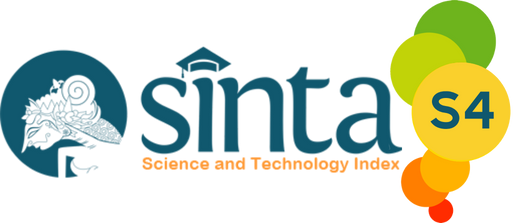The Role of Artificial Intelligence (AI) in Vocational Education
Abstract
Artificial Intelligence is a technology that has rapidly developed in this decade. Its capability to perform tasks previously achievable only by humans has made this technology popular and utilized across various sectors, including vocational education. In vocational education, Artificial Intelligence plays a role in enhancing the efficiency and effectiveness of teaching. One example is the development of adaptive learning programs that can adjust the curriculum according to students' abilities and needs. Additionally, Artificial Intelligence is also used to evaluate student performance and provide automatic feedback. This system can assist in assessing and monitoring student performance, enabling teachers to focus on teaching and student development. This study used the Systematic Literature Review (SLR) method. This method is used to identify, assess, evaluate, and interpret all available research within the field of the relevant phenomenon, guided by specific research questions. By using this method, a systematic review and identification of journals can be conducted, following predefined steps. The data for this study is obtained from relevant journals between the years 2013 to 2021, totaling 15 literature journals from various countries. The primary goal of this research is to provide a deeper understanding of the role of this technology in vocational education and to present a framework that can be used as a guide for the implementation of Artificial Intelligence. It is anticipated that this research will assist educators and decision-makers in effectively utilizing Artificial Intelligence to enhance learning, skills, and vocational student preparation for the continually evolving job market.
Keywords
Full Text:
PDFReferences
Anane, C. A. (2013). Competency based training: Quality delivery for technical and vocational education and training (TVET) institutions. Educational Research International, 2(2), 117–127.
Anitah, S. (2009). Teknologi pembelajaran. Yuma Pustaka.
Bereiter, C. (2005). Education and mind in the knowledge age. Lawrence Erlbaum Associates.
BOLDBERG, D. E. (1989). Genetic algorithms in search. Optimization and Machine Learning.
Das, S., & Nene, M. J. (2017). A survey on types of machine learning techniques in intrusion prevention systems. 2017 International Conference on Wireless Communications, Signal Processing and Networking (WiSPNET), 2296–2299.
Hernawati, K. (2012). Desain elearning adaptif berbasis cognitive styleuntuk pembelajaran matematika SMA kelas XII IPA. PYTHAGORAS Jurnal Pendidikan Matematika, 7(1). https://doi.org/10.21831/pg.v7i1.2835
Hidayat, R., & Abdillah, A. (2019). Ilmu pendidikan: konsep, teori dan aplikasinya. Lembaga Peduli Pengembangan Pendidikan Indonesia (LPPPI).
Huang, G.-B., Zhu, Q.-Y., & Siew, C.-K. (2006). Extreme learning machine: theory and applications. Neurocomputing, 70(1–3), 489–501. https://doi.org/10.1016/j.neucom.2005.12.126
Jean-Charles, A. (2018). Internet of things in education: Artificial intelligence voice assistant in the classroom. Society for Information Technology & Teacher Education International Conference, 883–885.
Kaplan, A., & Haenlein, M. (2019). Rulers of the world, unite! The challenges and opportunities of artificial intelligence. Business Horizons, 63. https://doi.org/10.1016/j.bushor.2019.09.003
Kusumadewi, S. (2003). Artificial intelligence (teknik dan aplikasinya). In Yogyakarta: Graha Ilmu. Graha Ilmu.
Luger, G. F. (2005). Artificial intelligence: structures and strategies for complex problem solving. Pearson education.
Madakam, S., Lake, V., Lake, V., & Lake, V. (2015). Internet of Things (IoT): A literature review. Journal of Computer and Communications, 3(05), 164. https://doi.org/10.4236/jcc.2015.35021
Molenaar, I. (2021). Personalisation of learning: Towards hybrid human-AI learning technologies. Blockchain, and Robots, 57–77. https://doi.org/10.1787/589b283f-en
Patrick, S., Kennedy, K., & Powell, A. (2013). Mean what you say: Defining and integrating personalized, blended and competency education. In International Association for K-12 Online Learning. ERIC.
Rich, E. (1983). Artificial intelligence. McGraw-Hill, Inc.
Somvanshi, M., Chavan, P., Tambade, S., & Shinde, S. V. (2016). A review of machine learning techniques using decision tree and support vector machine. 2016 International Conference on Computing Communication Control and Automation (ICCUBEA), 1–7. https://doi.org/https://doi.org/10.1109/ICCUBEA.2016.7 860040
Supiandi, I. (2016). Analisis digital assistant versi cortana, siri dan google now. INFOTECH Journal, 1(2). http://dx.doi.org/10.31949/inf.v1i2.39
Tewksbury, R., & Mustaine, E. E. (2012). Cracking open the black box of the manuscript review process: A look inside Justice Quarterly. Journal of Criminal Justice Education, 23(4), 399–422. https://doi.org/10.1080/10511253.2011.653650
Thupae, R., Isong, B., Gasela, N., & Abu-Mahfouz, A. M. (2018). Machine learning techniques for traffic identification and classifiacation in SDWSN: A survey. IECON 2018-44th Annual Conference of the IEEE Industrial Electronics Society, 4645–4650. https://doi.org/10.1109/IECON.2018.859 1178
Tjahyanti, L. P. A. S., Saputra, P. S., & Santo Gitakarma, M. (2022). Peran artificial intelligence (AI) untuk mendukung pembelajaran di masa pandemi Covid-19. KOMTEKS, 1(1).
Refbacks
- There are currently no refbacks.








